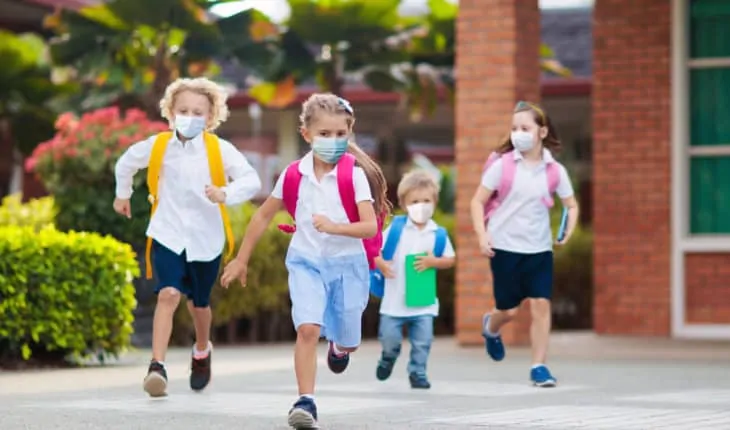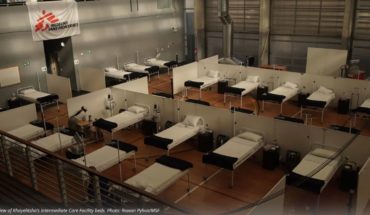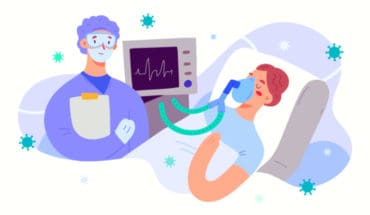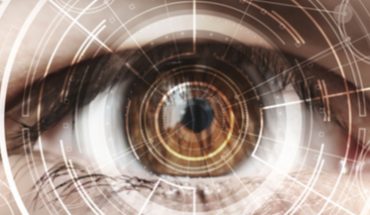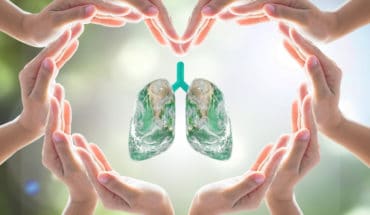The challenges of Covid-19 are particularly difficult for schools, nurseries and childcare providers. Attempting to socially distance within a school environment, particularly for younger children is extremely difficult.
Despite this, most Education and childcare settings remain open. This is mainly for priority groups during the Coronavirus lockdown measures (vulnerable children and children of critical workers). The Government is now encouraging parents of other groups of eligible children to send them back to school.
Safely returning more children to educational and childcare settings is vital to restart the economy. It will enable people to return to work.
This article seeks to provide clear direction to staff working in schools, colleges and childcare settings. Educating them on infection control, first aid and resuscitation in a childcare and educational setting.
The Government has published guidance on preparing for the wider opening of early years and childcare settings. There is also Actions for schools during the coronavirus (COVID-19) outbreak.
Effective Covid-19 infection protection and control
There are important actions that children and young people, their parents and those who work with them can take during the coronavirus outbreak. This will help prevent the spread of the virus.
In all education, childcare and social care settings, preventing the spread of coronavirus involves dealing with direct and indirect transmission. For instance, when in close contact with those sneezing and coughing and touching contaminated surfaces. A range of approaches and actions should be in action to do this. These can be a hierarchy of controls that, when implemented, creates an inherently safer system.
These include:
- minimising contact with individuals who are unwell. Ensure that those who have COVID-19 symptoms, or who have someone in their household who does, do not attend childcare settings, schools or colleges. There will need to be regular screening. This will ensure teachers, pupils and parents declare any changes to their Coronavirus status on a daily basis.
- cleaning hands more often than usual. Wash hands thoroughly for 20 seconds with running water and soap. Dry them thoroughly or use sanitiser ensuring that you cover all parts of the hands. Schools will need to provide hand sanitiser to facilitate this. It is vital that teachers continually reinforce the importance of hand and respiratory hygiene.
- ensuring good respiratory hygiene by promoting the ‘catch it, bin it, kill it’ approach. Schools should ensure every classroom has a bin with a lid. and that that someone empties it regularly throughout the day.
- Cleaning surfaces often using standard products, such as detergents and bleach. It will be necessary for most Schools to increase their cleaning regime. Also provide staff with suitable cleaning materials to maintain the necessary level of infection control. COVID-19: cleaning of non-healthcare settings guidance
- Regularly clean light switches, computer screens and mice, door knobs, lift buttons, bannisters, taps, loo flushes etc.
- Children should have their own pens, pencils, books etc. Avoid sharing any equipment wherever possible.
- minimising contact and mixing by altering, as much as possible. Including: the environment (such as classroom layout) and timetables (such as staggered break times).
- Classrooms should be well-ventilated. Schools should use outdoor space whenever possible.
Personal protective equipment (PPE) including face coverings and face masks
As at 13th June 2020, Government advice does not include the wearing of a face covering or face mask in schools or other education settings.
The Government advice states that ‘Face coverings may be beneficial for short periods indoors where there is a risk of close social contact with people you do not usually meet and where social distancing and other measures are hard to maintain, for example on public transport or in some shops. This does not apply to schools or other education settings. Schools and other education or childcare settings should therefore not require staff, children and learners to wear face coverings.
Changing habits, cleaning and hygiene are effective measures in controlling the spread of the virus. Young children, or those with special educational needs or disabilities should not wear masks as it may inadvertently increase the risk of transmission.’
Covid-19 Government measures
The Government state that the majority of staff in education settings will not require PPE beyond what they would normally need for their work. This is even if they are not always able to maintain a distance of 2 metres from others. PPE is only needed in a very small number of cases including:
- children, young people and students whose care routinely already involves the use of PPE due to their intimate care needs should continue to receive their care in the same way.
- if a child, young person or other learner becomes unwell with symptoms of coronavirus (COVID-19) while in their setting and needs direct personal care until they can return home. If contact with the child or young person is necessary, then the supervising adult should wear disposable gloves, a disposable apron and a fluid-resistant surgical face mask. Wear eye protection if a risk assessment determines that there is a risk of splashing to the eyes, for example from coughing, spitting, or vomiting. Schools will need to invest in this PPE to ensure it is available.
Shielded and clinically vulnerable children and young people
For the vast majority of children and young people, coronavirus (COVID-19) is a mild illness. Children and young people (0 to 18 years of age) who are clinically extremely vulnerable due to pre-existing medical conditions should shield. We do not expect these children to be attending school or college, and they should receive support at home as much as possible.
Clinically vulnerable (but not clinically extremely vulnerable) people are those at a higher risk of severe illness from coronavirus (COVID-19). A small minority of children will fall into this category. Parents should follow medical advice if their child is in this category.
Shielded and clinically vulnerable adults
Clinically extremely vulnerable individuals are to not to work outside the home. We are strongly advising people, including education staff, who are clinically extremely vulnerable to rigorously follow shielding measures in order to keep themselves safe. Staff in this position are not to attend work. Read COVID-19: guidance on shielding and protecting people defined on medical grounds as extremely vulnerable for more advice.
Clinically vulnerable individuals who are at higher risk of severe illness should take extra care. Observe social distancing and work from home where possible. Education and childcare settings should endeavour to support this. For example by asking staff to support remote education, carry out lesson planning or other roles from home.
If clinically vulnerable individuals cannot work from home, offer them the safest available on-site roles. Staying 2 metres away from others wherever possible. Although the individual may choose to take on a role that does not allow for this distance if they prefer to do so. If they have to spend time within 2 metres of other people, settings must carefully assess and discuss with them
Living with a shielded or clinically vulnerable person
If a child, young person or a member of staff lives with someone who is clinically vulnerable (but not clinically extremely vulnerable), including those who are pregnant, they can attend their education or childcare setting.
If a child, young person or staff member lives in a household with someone who is extremely clinically vulnerable, as set out in the COVID-19: guidance on shielding and protecting people defined on medical grounds as extremely vulnerable guidance, they should only attend an education or childcare setting if they can adhere to stringent social distancing. This may not be possible for very young children and older children. Especially without the capacity to adhere to the instructions on social distancing. If so, they should receive support to learn or work at home.
What happens if someone becomes unwell at an educational or childcare setting?
If anyone in an education or childcare setting becomes unwell they must be sent home. Then follow the COVID-19: guidance for households with possible coronavirus (COVID-19) infection guidance.
If a child is awaiting collection, they should move, if possible, to a room where they can isolate behind a shut door. This depends on the age of the child and with appropriate adult supervision if required. Ideally, open a window for ventilation. If it is not possible to isolate them, move them to an area which is at least 2 metres away from other people.
If they need to go to the bathroom while waiting, they should use a separate bathroom if possible. Clean and disinfect the bathroom using standard cleaning products.
Staff caring for the child should wear PPE while they await collection if a distance of 2 metres cannot be maintained. Such as for a very young child or a child with complex needs.
In an emergency, call 999 if they are seriously ill or injured or their life is at risk. Do not visit the GP, pharmacy, urgent care centre or a hospital.
If a member of staff has to help someone with symptoms, they do not need to go home unless they develop symptoms themselves (and in which case, a test is available) or the child subsequently tests positive.
They should wash their hands thoroughly for 20 seconds after any contact with someone who is unwell. Cleaning the area with normal household disinfectant after someone with symptoms has left is vital. This will reduce the risk of passing the infection on to other people. See the COVID-19: cleaning of non-healthcare settings guidance.
What happens if there is a confirmed case of coronavirus (COVID-19) in a setting?
When a child, young person or staff member develops symptoms compatible with coronavirus (COVID-19), they should be sent home to self-isolate for 7 days. Arrange to have a test to see if they have COVID-19. They can do this by visiting NHS.UK or contact NHS 119 via telephone. Their fellow household members should self-isolate for 14 days.
All staff and students who are attending an education or childcare setting will have access to a test if they display symptoms of coronavirus (COVID-19).
Where the child, young person or staff member tests negative, they can return to their setting. The fellow household members can end their self-isolation.
Where the child, young person or staff member tests positive, the rest of their class or group should be sent home. They must self-isolate for 14 days. The other household members of that wider class or group do not need to self-isolate. Unless the child, young person or staff member they live with in that group subsequently develops symptoms.
Test and Trace
As part of the national test and trace programme, they detect other cases within the cohort or in the wider setting, Public Health England’s local health protection teams will conduct a rapid investigation and will advise schools and other settings on the most appropriate action to take.
In some cases a larger number of other children, young people may self-isolate at home as a precautionary measure – perhaps the whole class, site or year group. Where settings are observing guidance on infection prevention and control, which will reduce risk of transmission, closure of the whole setting will not generally be necessary.
The Government offers guidance for special schools, specialist colleges, local authorities and any other settings managing children and young people with education, health and care plans, including those with complex needs.
- What is a seizure? - 13th March 2025
- Febrile Convulsions and Seizures in Children - 13th March 2025
- Why women are less likely to receive CPR or survive cardiac arrest - 6th March 2025
